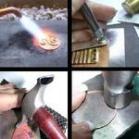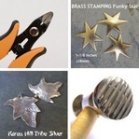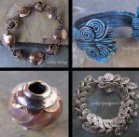Earrings On Fire Tutorial Question
by Joanne
(Sound Beach, New York)
Good Morning from New York!
The earrings on fire tutorial looks very interesting and is a direction I've been wanting to explore. I currently use a small butane kitchen type torch. Will the reticulation techniques you discuss in this tutorial work on 22 gauge sterling with this type of torch? I can get silver red hot with my torch using 9/16" disks. Thanks for your interesting tutorials and sharing your advice.
Warm wishes
Joanne
Stacy's Answer:
Hi Joanne!
There are a lot of different butane torches available out there and they do not all work well for basic soldering or jewelry fabrication projects. I used a MaxFlame butane torch for the tutorial. The MaxFlame torches look very similar to the butane kitchen torches I've seen at gourmet kitchen shops. Even though I have a propane/oxy set-up in my personal studio, I use the MaxFlame for class and tutorial projects so that I know the projects can be successfully made using one. Butane torches are a popular, affordable and comfortable choice for a lot of folks.
Can you melt silver into a ball with your torch Joanne? If so, you should be OK. Sterling silver will melt (reach it's liquidous stage) before copper does which is important for the fused earrings and after the temp necessary for reticulation. To reticulate Sterling silver, you need a pickle pot or hot pickling solution and your torch needs to be able to bring the silver to the very hot orange stage which is right before the puddle stage. :-) If the torch heats the metal to those temperatures, then the much cooler blush color necessary for soldering Sterling silver should be no problem.
22 gauge is a nice thickness for the reticulated earring project, but you can use 20 gauge also. 24 gauge will reticulate, but because of the metal thinness combined with the small discs, it's easier to melt rather than reticulate. I call that good torch control practice!
I hope you give the projects a try! If you run into more questions, just ask. I'm just an email away.
Comments for Earrings On Fire Tutorial Question
|
||
|
||
|
||
|
Click here to add your own comments Join in and write your own page! It's easy to do. How? Simply click here to return to Jewelry Q & A. |
















